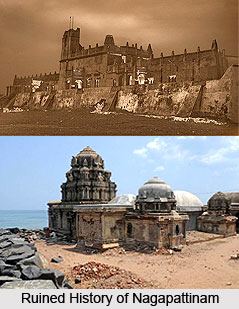 History of Nagapattinam covers the ancient and medieval rulers of South India and the glorious rule of the South Indian Dynasties. To the national and international level tourists, Nagapattinam is famous for its pilgrimage tourism sites.
History of Nagapattinam covers the ancient and medieval rulers of South India and the glorious rule of the South Indian Dynasties. To the national and international level tourists, Nagapattinam is famous for its pilgrimage tourism sites.
Early History of Nagapattinam
During the Sangam period, Nagapattinam became the centre of arts and architecture Nagapattinam was ruled by the Sangam dynasty from 3rd century BC to 3rd century AD. There are urn burials excavated in and around the city of Nagapattinam from the Sangam period indicating some level of human habitation. The neighbouring port, Kaveripoompattinam, which is known as the modern day Poompuhar, was the capital of the Chola kingdom. Nagapattinam was referred widely in Tamil scriptures like "Pa??inappalai", an ancient scripture of Tamil Era.
The early works of Tevaram by the 7th-century poets Appar and Sambandar mention the existence of Nagapattinam. Nagapattinam at that time was built with fortified walls, busy road building and a busy port. The inscriptions from the Kayarohanswami temple indicate the construction was initiated during the reign of the Pallava king, Narasimha Pallava II, who ruled this region from 691-729AD. A Buddhist Pagoda was built under Chinese influence by the Pallava king and town was frequented by Buddhist travellers. Thirumangai Azhwar, Vaishnavite Saint Poet of 9th Century is believed to have stolen the golden Buddha statue to fund the Ranganthaswamy Temple at Srirangam. In the 11th century, Chudamani Vihara, a Buddhist monastery was built by Javanese king Sri Vijaya Soolamanivarman with the patronage of Raja Raja Chola of Chola Dynasty. In the early phase of medieval period, Nagapattinam was the prominent port of Cholas for trade and conquering gateway to the east.
Medieval History of Nagapattinam
In the early 16th century the traders of Portuguese East India Company started business with the town. There they established a commercial centre in 1554. The Portuguese also conducted missionary enterprise here. In 1658, the Dutch East India Company established an agreement between King Vijaya Nayakkar of Thanjavur on 5th January 1662. About ten villages were transferred from the Portuguese to the Dutch. These included the Nagapattinam Port, Puthur, Muttam, Poruvalancheri, Anthanappettai, Karureppankadu, AzhingiMangalam, Sangamangalam, Thiruthinamangalam, Manjakollai, Nariyankudi. The Christian churches and a hospital were built by the Dutch traders. They released coins with the name Nagapattinam engraved in Tamil. As per agreement between the first Maratha King Egoji of Thanjavur and the traders of Dutch East India Company, Naagapattinam and surrounding villages were handed over to the Government of Dutch East India Company on 30 December 1676. In 1690, the capital of Dutch Coromandel changed from Pulicat to Nagapattinam.
Modern History of Nagapattinam
Nagapattinam fell into the hands of the British East India Company in the year 1781. British East India Company annexed Nagapattinam after two naval battles between British East India Company and French East India Company fleets were fought off the coast of "Negapatam" or Nagapattinam. The town was taken by the British navel forces from the Dutch in 1781. When the Dutch and British reached a peace agreement in 1784, Nagapattinam was formally ceded to the British East India Company. From the year 1799 to 1845, Nagapttinam was the headquarters of Tanjore district. Nagapattinam and Nagore were incorporated as a single municipality in 1866. The town remained one of the chief ports to the Madras Presidency. The port suffered decline after the inclusion of Tranquebar and Tuticorin ports. After the Independence of India, Nagapattinam is directly included in Nagapattinam District in the year 1991.



















